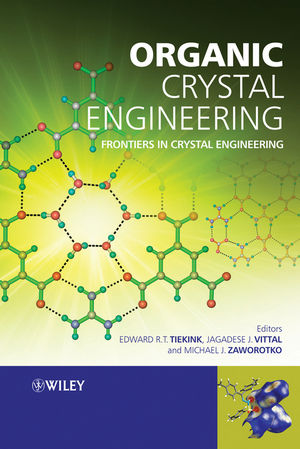Organic Crystal Engineering: Frontiers in Crystal EngineeringISBN: 978-0-470-31990-1
Hardcover
336 pages
March 2010
 |
||||||
Preface.
1 The Role of the Cambridge Structural Database in Crystal Engineering (Andrew D. Bond).
1.1 Introduction.
1.2 Organisation and Management of Crystallographic Information.
1.3 Organisation of Crystallographic Information for Crystal Engineering.
1.4 New Tools for Database Research.
1.5 Search for Functional Group Exchanges: GRX.
1.6 Search for Solvated and Unsolvated Structures: Solvates.
1.7 Clustering and Classifying CSD Search Results: dSNAP.
1.8 The PXRD Profile as a Structural Descriptor.
1.9 Identifying Supramolecular Constructs: XPac.
1.10 Concluding Remarks: the Future Role of Crystallographic Databases.
References.
2 Computational Crystal Structure Prediction: Towards In Silico Solid Form Screening (Graeme M. Day).
2.1 Introduction.
2.2 Methods used to Predict Crystal Structures.
2.3 Current Capabilities of Crystal Structure Prediction.
2.4 Exploration of Crystal Forms. A Case Study: Carbamazepine.
2.5 Summary.
Acknowledgments.
References.
3 Multi-component Pharmaceutical Crystalline Phases: Engineering for Performance (Matthew L. Peterson, Edwin A. Collier, Magali B. Hickey, Hector Guzman and Örn Almarsson).
3.1 Introduction.
3.2 Exploring Crystal Form Diversity.
3.3 High-throughput Experimentation.
3.4 Examples of ‘Form and Formulation’.
3.5 AMG517 and Celecoxib – ‘Spring and Parachute’ Approach.
3.6 Carbamazepine - Stabilization Against a Hydrate.
3.7 Theophylline:Phenobarbital - Two is Better Than One.
3.8 Delaviridine Mesylate - Material Misbehavior.
3.9 Summary and Outlook.
References.
4 Complex Formation of Surfactants with Aromatic Compounds and their Pharmaceutical Applications (Yuji Ohashi, Keiju Sawada and Nahoko Iimura).
4.1 Introduction.
4.2 Structures of the Complexes Formed Between Surfactants and Aromatic Compounds.
4.3 Complex Formation of Aromatic Compounds Containing an Hetero Ring.
4.4 Complex Formation of Biphenyl with Cationic Surfactants.
4.5 Complex Formation of Odd-Number Surfactants with Biphenyl.
4.6 Common Packing Mode in the Complexes.
4.7 Complex Formation by Grinding in a Mortar.
4.8 C-H...p interactions.
4.9 Complex Formation of Anionic Surfactants with Aromatic Compounds.
4.10 Increased Solubility of Insoluble Drugs.
4.11 Enhanced Thermal Stability of Perfumes.
4.12 Complex Formation with Surfactants other than Quaternary Alkylammonium Salts.
4.13 Hydroquinone Complexes.
4.14 Application to Whitening Agents.
Acknowledgments.
References.
5 Hydrogen Bonding and Molecular Packing in Multi-Functional Crystal Structures (Ashwini Nangia).
5.1 Introduction.
5.2 Hydrogen Bonding in Ureas and Amides.
5.3 Pyridyl Ureas and Amides.
5.4 Nitrophenyl Ureas and Amides.
5.5 Molecular Conformation and Hydrogen Bonding.
5.6 Supramolecular HSAB Interactions.
5.7 gem-alkynols.
5.8 Conclusions.
Acknowledgments.
References.
6 Persistence of N-H...S Hydrogen Bonding in Thiocarbamide Structures (Edward R. T. Tiekink).
6.1 Introduction.
6.2 Supramolecular Aggregation Patterns in the Thiocarbamides.
6.3 Conclusions.
References.
7 Crystal Engineering with the Molecules Containing Amide and Pyridine Functionalities (Kumar Biradha and Lalit Rajput).
7.1 Introduction.
7.2 Primary Amides Containing the Pyridine Moiety.
7.3 Co-crystals with Primary Amidopyridines.
7.4 Secondary Amides Containing a Pyridine Moiety.
7.5 Bis-Amidopyridine Derivatives.
7.6 Two-component Structures Containing Secondary Amides and Pyridine Derivatives.
7.7 Triamidopyridine Derivatives.
7.8 Conclusions.
Acknowledgements.
References.
8 Urea/Thiourea-Anion Host Lattices, Stabilization of Labile Species, and Designed Construction of Rosette Ribbon and Layers (Thomas C. W. Mak, Chi-Keung Lam, Jie Han, Qi Li and Feng Xue).
8.1 Introduction.
8.2 Inclusion Compounds with Urea/Thiourea-Anion Host Lattices.
8.3 Stabilization of Cyclic Oxocarbon Dianions by Hydrogen Bonding with Urea/Thiourea.
8.4 Supramolecular Assembly Based on the Rosette Motif.
8.5 Conclusion and Outlook.
Acknowledgments.
References.
Index.



